How Pallet Inverters Solve Smart Factory Trends and Industry 4.0 Upgrades in South Korea?
Are you feeling the pressure to modernize your factory operations? You know that automation is the future, but high labor costs, inefficient logistics, and aging equipment create bottlenecks that hurt your bottom line. You see competitors moving towards smart factories, and you worry about being left behind. This struggle is real for many factory owners I speak with. It's a constant battle to improve efficiency while managing costs. This challenge can feel overwhelming, especially when you need every piece of equipment to deliver a clear return on investment. The good news is that sometimes, a simple, targeted solution can unlock massive gains. Visionary manufacturers, particularly in tech-forward hubs like South Korea, are using pallet inverters to solve these exact problems and pave the way for their Industry 4.0 ambitions.
Pallet inverters solve smart factory trends and Industry 4.0 upgrades by automating a critical yet often overlooked process: transferring goods from one pallet to another. In South Korea, where efficiency and technology are paramount, these machines eliminate manual handling, reduce labor costs, and prevent product damage. They act as a vital bridge, allowing seamless integration with automated systems like AGVs and Warehouse Management Systems (WMS). This integration creates a connected, data-driven logistics flow, which is the core of any true Industry 4.0 initiative.
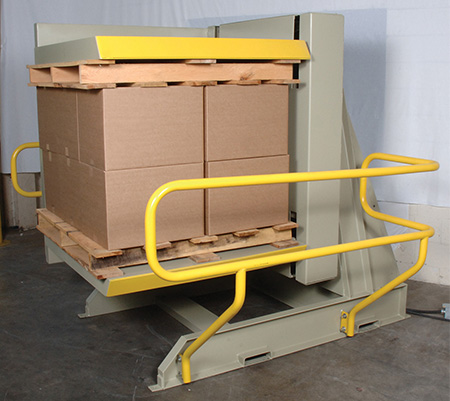
I understand that as a practical business leader, you need more than just a high-level overview. You need to see how this technology translates into tangible benefits for your specific operation. How does a machine that flips pallets truly address the complex challenges of running a large-scale manufacturing plant, like a steel mill? Let's break down the specific problems that pallet inverters solve and explore how they are becoming a cornerstone of modern factory upgrades, using South Korea's progress as our guide.
How do Pallet Inverters Directly Address Rising Labor Costs and Safety Concerns?
You see the numbers every quarter. Labor costs continue to rise, and finding reliable workers for physically demanding jobs is getting harder. On top of that, a single workplace injury can lead to costly downtime, insurance claims, and a drop in team morale. Manually handling heavy, palletized loads is one of the highest-risk activities on the factory floor. It's slow, inefficient, and a constant source of potential safety incidents. This is a problem I saw repeatedly as an engineer and now as a business owner. This manual bottleneck not only drives up operational costs but also exposes your company to significant financial and human risk.
A pallet inverter directly addresses these issues by completely automating the task of load transfer. It safely and quickly inverts a full pallet, allowing an operator to switch the bottom pallet with zero manual lifting. This immediately reduces the need for manual labor in that part of your process and virtually eliminates the risk of strains, sprains, and other injuries associated with lifting heavy or awkward loads. For a leader focused on both financial stability and employee well-being, this is a clear and direct solution.
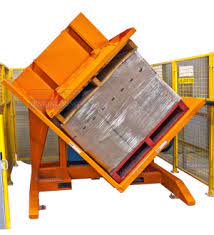
To truly grasp the impact, we need to look beyond the initial machine cost and analyze the deeper, long-term value. For a leader like Javier, who conducts rigorous feasibility analyses, this is where the real story is. The ROI isn't just about replacing a salary; it's about fundamentally changing the cost and risk structure of your logistics.
The True Cost of Manual Pallet Handling
When I work with clients, I encourage them to calculate the hidden costs of manual processes. It's more than just wages. It includes insurance, training, potential injury claims, and the cost of inefficiency. Let's compare the two approaches for a heavy industry environment.
| Cost Factor | Manual Handling (Per Year, Per Position) | Automated Handling (Pallet Inverter) |
|---|---|---|
| Labor Wages | $40,000+ | $0 (Reassigns worker to higher-value task) |
| Worker's Comp Insurance | High premiums due to risk | Lower premiums due to reduced risk |
| Downtime from Injury | Average 1-2 incidents per year | Virtually zero incidents |
| Recruitment & Training | Ongoing costs due to turnover | One-time training for existing staff |
| Process Speed | 5-10 minutes per pallet | ~60 seconds per pallet |
| Product Damage | Higher risk of drops or spills | Secure clamping mechanism minimizes risk |
Looking at this table, the financial argument becomes very strong. The investment in a pallet inverter pays for itself not just by saving on salary, but by creating a more stable, predictable, and safer operation.
Designing for Safety in Heavy Industries
In a steel mill, you're not just moving boxes of consumer goods. You're handling heavy, dense products like steel wire coils or stacked metal sheets. Safety is not a suggestion; it's a requirement. A standard pallet inverter might not be sufficient. That's why we, as engineers, must design for the specific application. For heavy loads, this means features like:
- Heavy-duty construction: Using thicker steel and reinforced frames to handle weights of 2,000 kg or more.
- Powerful clamping pressure: Hydraulic systems that can securely hold uneven or shifting loads without crushing the product.
- Smooth, controlled rotation: Ensuring the inversion process is steady to prevent sudden movements that could destabilize the load.
South Korean manufacturers, facing some of the world's highest safety standards, were early to adopt this mindset. They understood that investing in robust, application-specific equipment was the only way to achieve both safety and efficiency.
What is the Role of Pallet Inverters in Optimizing Warehouse Space and Logistics Flow?
Is your warehouse getting crowded? Do you find yourself spending too much money on expensive, high-quality pallets only to ship them out, never to be seen again? This is a common logistics puzzle. You need durable, clean, and often standardized pallets for your internal automated systems, but you need to use cheaper, disposable wooden pallets for shipping to customers. The process of manually transferring goods between these pallet types creates a major bottleneck, slowing down both production and shipping and cluttering your valuable warehouse space.
Pallet inverters serve as the perfect bridge in this scenario, optimizing your entire logistics flow. By providing a quick and automated way to switch from an in-house plastic or metal pallet to a shipping pallet (or vice versa), they streamline the entire process. This simple capability unlocks significant efficiencies. It frees up valuable floor space previously used for manual restacking, reduces the time trucks spend waiting at the loading dock, and allows you to maintain a clean, efficient internal pallet pool without losing expensive assets.
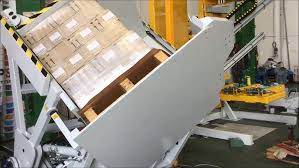
This goes beyond simple convenience. For a CEO focused on increasing capacity utilization and reducing operational costs, optimizing logistics is a key lever for growth. Let's dive deeper into how this seemingly simple machine can transform your warehouse and supply chain.
From Shipping Pallets to In-House Pallets
One of the most powerful applications I've helped clients implement is the "two-pallet system." This is especially relevant for businesses that export a significant portion of their products. The economics are simple.
- In-House Pallets: These are high-quality, durable pallets, often made of plastic or metal. They are uniform in size and condition, making them perfect for use with Automated Guided Vehicles (AGVs), automated storage and retrieval systems (AS/RS), and conveyors. They represent a significant capital investment.
- Shipping Pallets: These are typically low-cost wooden pallets. They are designed for one-way trips and meet international shipping standards like ISPM 15. You don't want these running through your sensitive automated equipment, and you certainly don't want to lose your expensive in-house pallets by shipping them out.
The pallet inverter is the gateway between these two systems. A finished product arrives at the shipping dock on a clean, in-house pallet. The inverter quickly swaps it to a wooden shipping pallet. The expensive in-house pallet immediately goes back into your internal loop. This strategy, popular in highly efficient South Korean factories, has a direct impact on the bottom line.
| Metric | Without Pallet Inverter | With Pallet Inverter |
|---|---|---|
| Annual Pallet Loss | High (losing expensive in-house pallets) | Near Zero (only cheap pallets are shipped) |
| Warehouse Cleanliness | Debris from wooden pallets enters facility | Contained at shipping dock |
| Automation Compatibility | Poor (inconsistent wooden pallets jam systems) | High (standardized internal pallets) |
| Loading/Unloading Speed | Slow (manual transfer required) | Fast (automated transfer) |
Boosting Throughput and Reducing Bottlenecks
Every minute a truck waits at your loading dock is lost money and a potential disruption to your schedule. By automating the pallet transfer process, you can dramatically increase your shipping and receiving throughput. What used to take two workers 10 minutes to do manually can be done by one worker in about 60 seconds.
Think about the ripple effect. Faster loading means more trucks can be processed per day. It means production lines don't have to wait for raw materials to be transferred from shipping pallets to in-house pallets. This directly supports the goal of increasing equipment effective run time. It's a clear example of how solving one small bottleneck can have a positive impact on the entire production chain, a key principle of lean manufacturing that I have always admired and implemented.
How Can Pallet Inverters Integrate with Existing MES and IoT Systems for a True Industry 4.0 Upgrade?
You've invested in a Manufacturing Execution System (MES) and are exploring IoT sensors. Your goal is total production visibility. But you have "islands of automation"—machines and processes that work well on their own but don't communicate with each other. This lack of connection is a major barrier to achieving a true Industry 4.0 smart factory. A key logistics step, like pallet handling, remains a "black box" if it's done manually or with unconnected equipment. It's a gap in your data stream, preventing you from seeing the complete picture of your operations.
A modern pallet inverter is designed to fill this gap. It's more than just a mechanical device; it's a data-gathering node that can be fully integrated into your factory's digital ecosystem. By connecting to your MES and IoT platforms, the pallet inverter becomes a source of valuable information. It can report on cycle times, pallet counts, and operational status, providing the real-time data needed for smart scheduling and predictive maintenance. This integration turns a simple piece of handling equipment into an active participant in your Industry 4.0 strategy.
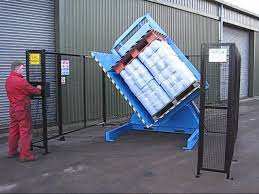
For a forward-thinking leader aiming for comprehensive digitalization, this is a critical point. You're not just buying a machine; you're buying a data point. Let's explore how this integration works in practice and why it's a cornerstone of the smart factories being built in South Korea today.
Creating a Connected Data Stream
The key to Industry 4.0 is data. A smart pallet inverter is equipped with sensors and a PLC (Programmable Logic Controller) that can communicate with your central factory systems. Here’s the kind of data it can provide:
- Cycle Count: Tracks every time the machine is used. This data feeds into the MES for productivity analysis.
- Cycle Time: Measures how long each pallet swap takes, helping to identify inefficiencies.
- Fault Codes: Instantly reports any operational issues to the maintenance team, enabling predictive maintenance instead of reactive repairs.
- Weight Data (with integrated scales): Can verify that pallet loads are within the correct weight specifications before they are shipped or stored.
This data stream is invaluable. For example, your MES can use the pallet inverter's cycle count to automatically trigger a work order in the shipping department. Or, if the cycle time starts to increase, it could signal a potential mechanical issue before it causes a breakdown. This is how you move from just automating a task to making the task intelligent.
The Role in a Fully Automated Line
Let's visualize a truly integrated process, something I've helped design for ambitious clients.
- Arrival: An AGV, directed by the Warehouse Management System (WMS), brings a pallet of finished steel wire from the production line to the pallet inverter.
- Communication: The AGV signals to the inverter that it has arrived. The inverter's sensors confirm the pallet is in the correct position.
- Action: The inverter automatically clamps the load, inverts it, and swaps the expensive in-house pallet for a cheap wooden shipping pallet. The entire action is logged in the MES.
- Departure: The inverter signals to the WMS that the task is complete. A different AGV is dispatched to move the now-ready-for-shipping pallet to the loading dock. The original in-house pallet is taken back into the factory loop.
This entire sequence happens with zero human intervention. It’s fast, flawless, and fully documented. This is the smart factory vision that leaders in South Korea are building, and the pallet inverter is a surprisingly crucial piece of that puzzle. It physically and digitally connects different stages of the logistics process.
Beyond the Machine: Why is Choosing the Right Partner as Crucial as the Technology Itself?
You've been in this industry for over 25 years. You know that buying a piece of equipment is the easy part. The real challenge is making sure it works, that it keeps working, and that the supplier is there for you when problems arise. We’ve all heard stories of buying a machine from a company that offered the lowest price, only for that company to disappear when it came time for installation support, spare parts, or technical advice. The initial savings quickly evaporate when you face unexpected downtime and a lack of support.
This is why, as someone who has built a factory from the ground up, I believe that choosing a strategic partner is far more important than just choosing a supplier. A true partner doesn't just sell you a machine. They invest time to understand your unique challenges, from the specific weight of your steel coils to your goals for digital transformation. They provide a "Total Solution," which means supporting you through selection, installation, training, and long-term maintenance. They act as an advisor, helping you make the right decisions for the future of your factory.
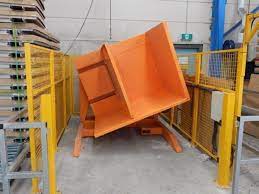
As a practical entrepreneur, you look for long-term value and stability. This is a philosophy I share deeply. The relationship you have with your equipment provider is a direct reflection of that philosophy. It's about building a foundation for success together.
My Journey: From Engineer to Owner
I didn't start my career as a business owner. I started as an engineer on the factory floor. I was the one who had to deal with equipment that broke down and suppliers who wouldn't answer the phone. I learned firsthand that the true cost of a machine isn't its purchase price; it's the cost of unreliability.
When I founded SHJLPACK, I made a promise to myself and my clients. I would build the kind of company I always wanted to work with. A company that listens. A company that provides robust, reliable equipment designed for the real world. And most importantly, a company that sees its clients' success as its own success. I achieved my own financial independence because of the opportunities this industry gave me, and helping my clients grow their businesses is my way of giving back. I understand your journey from team leader to owner because, in many ways, I have walked a similar path. We both know that trust and reliability are the currencies of this business.
What "Total Solution for Wrapping Machine" Really Means
Our slogan isn't just marketing. It's our operational blueprint. For us, a "Total Solution" includes:
- Deep Consultation: We start by listening. We want to understand your production flow, your pain points, and your long-term goals like reducing energy costs and advancing digitalization.
- Custom Design: A pallet inverter for a food company is different from one for a steel mill. We engineer the solution to fit your product, your space, and your operational needs.
- Seamless Installation & Training: Our job isn't done when the machine ships. We support your team to ensure the equipment is installed correctly and your operators are fully trained to use it safely and efficiently.
- Long-Term Partnership: We are here for you for the long haul, providing spare parts, technical support, and advice on future upgrades. We want to be your go-to advisor for all things related to packing and material handling.
When you evaluate a potential supplier, I encourage you to ask them these questions. Their answers will tell you everything you need to know about whether they are a simple vendor or a potential strategic partner.
Conclusion
Pallet inverters are more than machines; they are a strategic step towards a safer, more efficient, and future-ready factory. Let's build that future together.



